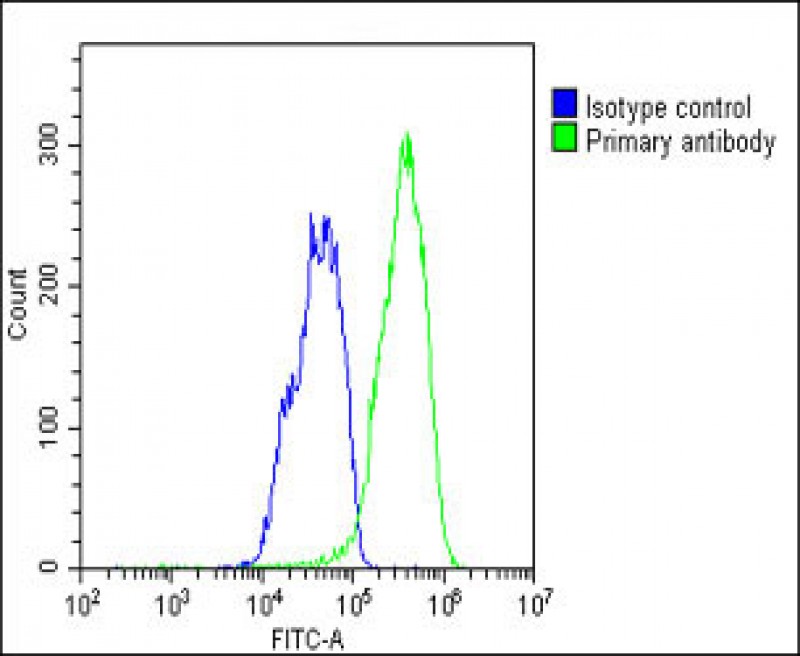SEPP1 Antibody (Center)
Affinity Purified Rabbit Polyclonal Antibody (Pab)
- 产品详情
- 实验流程
- 背景知识
Application
| WB, FC, E |
|---|---|
| Primary Accession | P49908 |
| Other Accession | NP_001078955.1, NP_005401.3 |
| Reactivity | Human, Rat |
| Host | Rabbit |
| Clonality | Polyclonal |
| Isotype | Rabbit IgG |
| Calculated MW | 43174 Da |
| Antigen Region | 233-262 aa |
| Gene ID | 6414 |
|---|---|
| Other Names | Selenoprotein P, SeP, SEPP1, SELP |
| Target/Specificity | This SEPP1 antibody is generated from rabbits immunized with a KLH conjugated synthetic peptide between 233-262 amino acids from the Central region of human SEPP1. |
| Dilution | WB~~1:1000 FC~~1:25 E~~Use at an assay dependent concentration. |
| Format | Purified polyclonal antibody supplied in PBS with 0.09% (W/V) sodium azide. This antibody is purified through a protein A column, followed by peptide affinity purification. |
| Storage | Maintain refrigerated at 2-8°C for up to 2 weeks. For long term storage store at -20°C in small aliquots to prevent freeze-thaw cycles. |
| Precautions | SEPP1 Antibody (Center) is for research use only and not for use in diagnostic or therapeutic procedures. |
| Name | SELENOP {ECO:0000303|PubMed:27645994, ECO:0000312|HGNC:HGNC:10751} |
|---|---|
| Function | Might be responsible for some of the extracellular antioxidant defense properties of selenium or might be involved in the transport of selenium. May supply selenium to tissues such as brain and testis. |
| Cellular Location | Secreted. Note=Passes from plasma into the glomerular filtrate where it is removed by endocytosis mediated by LRP2 in the proximal tubule epithelium. {ECO:0000250|UniProtKB:P70274} |
| Tissue Location | Made in the liver and heart and secreted into the plasma. It is also found in the kidney |
For Research Use Only. Not For Use In Diagnostic Procedures.
Provided below are standard protocols that you may find useful for product applications.
BACKGROUND
This gene encodes a selenoprotein containing multiple selenocysteine (Sec) residues, which are encoded by the UGA codon that normally signals translation termination. The 3' UTR of selenoprotein genes have a common stem-loop structure, the sec insertion sequence (SECIS), which is necessary for the recognition of UGA as a Sec codon rather than as a stop signal. This selenoprotein is an extracellular glycoprotein, and is unusual in that it contains 10 Sec residues per polypeptide. It is a heparin-binding protein that appears to be associated with endothelial cells, and has been implicated to function as an antioxidant in the extracellular space. Several transcript variants, encoding either the same or different isoform, have been found for this gene.
REFERENCES
Sun, W., et al. Br. J. Nutr. 104(9):1283-1287(2010)
Roman, M., et al. Transl Res 156(4):242-250(2010)
Meplan, C., et al. Carcinogenesis 31(6):1074-1079(2010)
Davila, S., et al. Genes Immun. 11(3):232-238(2010)
Takemoto, A.S., et al. Ethn Dis 20 (1 SUPPL 1), S1-S925 (2010) :
终于等到您。ABCEPTA(百远生物)抗体产品。
点击下方“我要评价 ”按钮提交您的反馈信息,您的反馈和评价是我们最宝贵的财富之一,
我们将在1-3个工作日内处理您的反馈信息。
如有疑问,联系:0512-88856768 tech-china@abcepta.com.























 癌症的基本特征包括细胞增殖、血管生成、迁移、凋亡逃避机制和细胞永生等。找到癌症发生过程中这些通路的关键标记物和对应的抗体用于检测至关重要。
癌症的基本特征包括细胞增殖、血管生成、迁移、凋亡逃避机制和细胞永生等。找到癌症发生过程中这些通路的关键标记物和对应的抗体用于检测至关重要。 为您推荐一个泛素化位点预测神器——泛素化分析工具,可以为您的蛋白的泛素化位点作出预测和评分。
为您推荐一个泛素化位点预测神器——泛素化分析工具,可以为您的蛋白的泛素化位点作出预测和评分。 细胞自噬受体图形绘图工具为你的蛋白的细胞受体结合位点作出预测和评分,识别结合到自噬通路中的蛋白是非常重要的,便于让我们理解自噬在正常生理、病理过程中的作用,如发育、细胞分化、神经退化性疾病、压力条件下、感染和癌症。
细胞自噬受体图形绘图工具为你的蛋白的细胞受体结合位点作出预测和评分,识别结合到自噬通路中的蛋白是非常重要的,便于让我们理解自噬在正常生理、病理过程中的作用,如发育、细胞分化、神经退化性疾病、压力条件下、感染和癌症。







